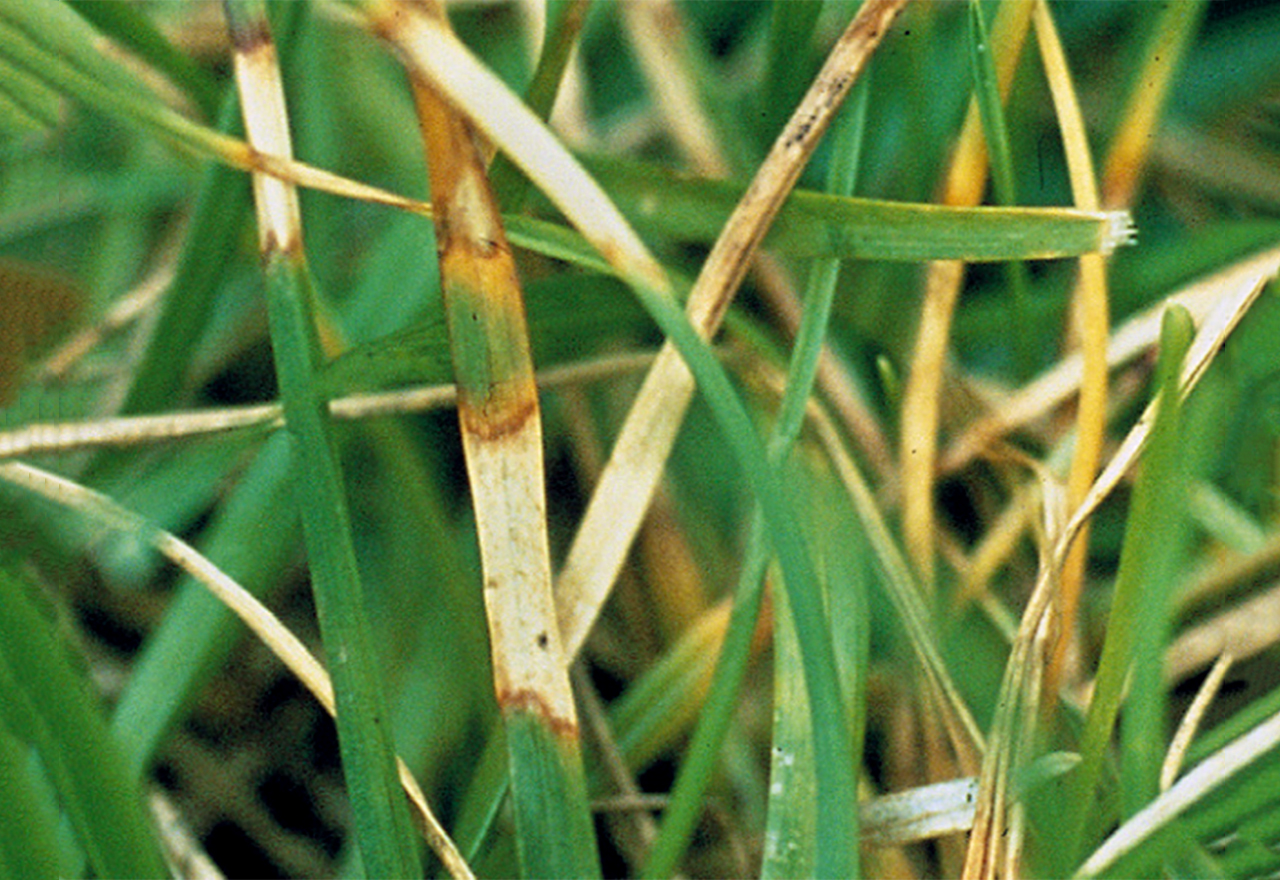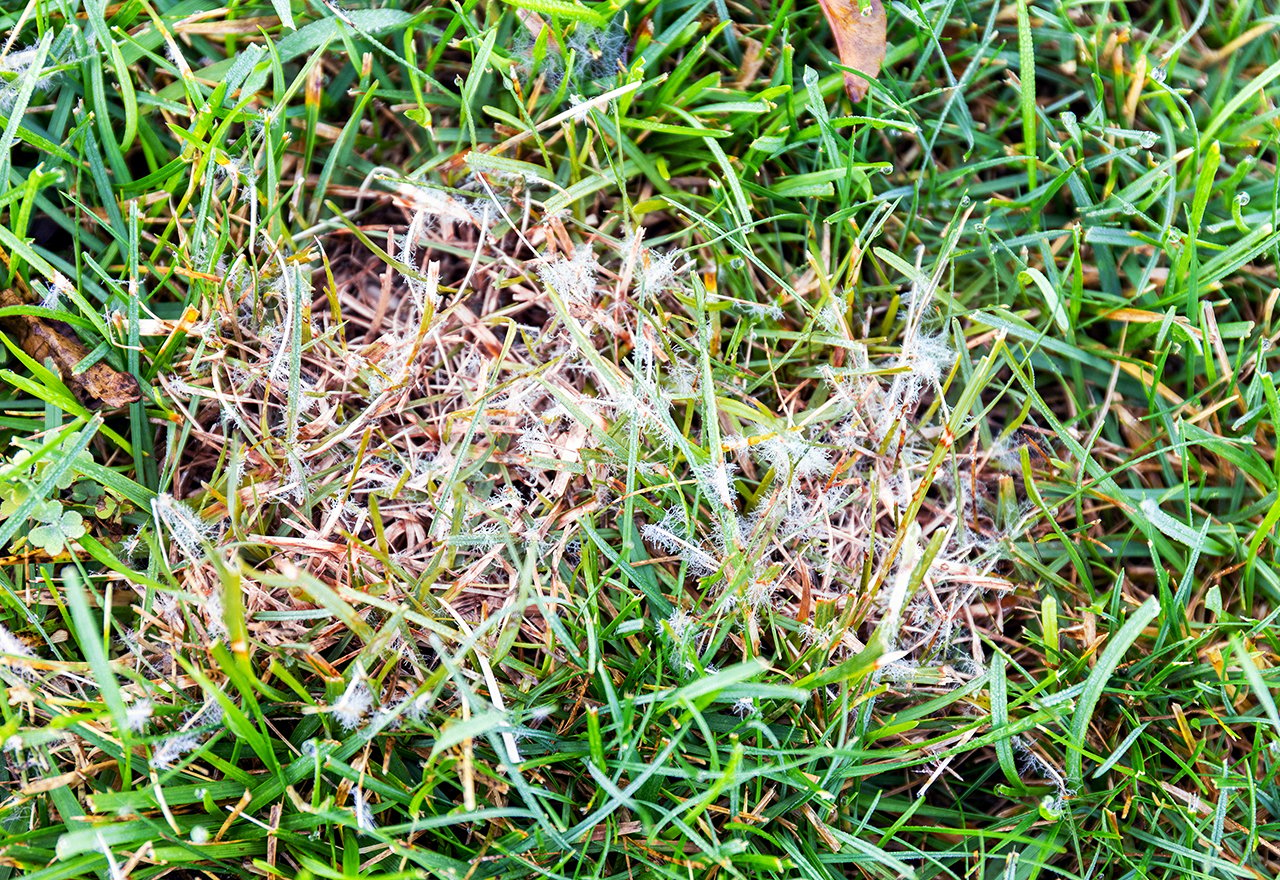Caused by a Fungal Organism, Grass Develops Dead, Straw-Colored Spots
We see Dollar Spot throughout the entire growing season: late Spring into the Fall or even early Winter. It manifests as lesions of dead, straw-colored spots in the middle of grass blades with black to dark red edges. In larger infected areas of grass, spots join together and look like larger brown areas or spots the size of silver dollars. The spots will get larger, the longer the disease is not treated. The lesions will spread over the rest of the grass blade and kill the top of the blade. When the grass is damp (from dew, irrigation or rain), fuzzy white mycelium can be seen on blighted grass. Dollar Spot will not usually kill your lawn permanently, as only very bad infestations affect roots. Dollar Spot Disease affects all varieties of turfgrass, especially Kentucky Bluegrass. Tall Fescue is somewhat resistant.
The fungus survives on “causal” stomata that can live for lengthy periods of unfavorable conditions on grass clippings, in thatch or in soil (especially when damp). It grows and thrives when daytime temperatures remain over 50oF. When daytime temperatures reach 90oF; however, the disease no longer spreads. Beyond simply growing outward, the fungus can spread from one area to another via shoes, animals or mowing equipment.
Dollar Spot Disease is the most prominent lawn problem in the United States. Golf course turf managers spend more money on fungicides fighting this lawn disease compared to all others. We’d like to offer you organic methods to fight the disease, instead of fungicides that will harm soil biota, animals and bugs, as well as negatively impact waterways.

A fungal organism causes Dollar Spot Disease. There was a lot of disagreement over the exact fungus in the past. The University of Delaware Extension tells us that the disease is caused by “fungi in the genus Clarireedia (formerly Sclerotinia homoeocarpa). Four Dollar Spot pathogens are in the genus Clarireedia: C. jacksonii, C. monteithiana, C. homoeocarpa, and C. bennettii. However, most of the Dollar Spot Disease incidences worldwide are caused by C. jacksonii and C. monteithiana, which occur on cool-season and warm-season grass hosts, respectively.”
The fungus thrives and spreads during longer periods when grass remains wet, 10 to 12 continuous hours. Heavy dews from late Spring nights or heavy rains in the Summer are most conducive to the disease. Additionally, the disease thrives on lawns with low nitrogen in the soil. Of course, stressed lawns are most susceptible to disease in general, especially during droughts.
If you have an infestation of Dollar Spot, we have a few recommendations. First, apply Neem Oil, our natural fungicide alternative, to the diseased spots. Water only when needed, or at the very most only every three to four days, in the morning or early afternoon. We like to water deeply and infrequently, instead of just a little bit every day. Feed your lawn organically, to avoid killing soil organisms that fight disease-causing fungi. Add resistant grasses through Slice Seeding in Tall Fescue (or if it’s really bad, you could start over with a Lawn Renovation). Minimizing your thatch layer is very important to treat and prevent Dollar Spot. In addition to providing a happy home for the fungus, a heavy thatch layer keeps water on the surface of the soil and prevents it from reaching the roots. Our Liquid Aeration service in the Spring and Core Aeration service in the Fall, will greatly help you achieve this. We provide these services but you can also aerate your lawn on your own with our recommended in-house DIY product, Liquid Aerator).
We say this a lot, but lawns that are healthy have fewer problems. Dollar Spot Disease is mostly a problem in lawns that have a heavy thatch layer, are cut very short or get watered too often for short periods of time.
Late Spring fertilizing will help prevent Dollar Spot Disease. We have in-house products specific to the Spring and Fall. We like to recommend a double dose in the Spring (one around Easter and the other around Memorial Day) and two more in the Fall (one around Labor Day and the second around Halloween).
Additionally, consider our Organic Compost Topdressing service in the Fall, which will add beneficial biology and keep your grass healthier and better able to defend itself against diseases.
We also encourage you to add some Microclover to your lawn. As a legume, Microclover will passively add nitrogen to your soil, which will help your grass stay green the entire Summer. The variety of Microclover we sell is smaller and does not flower, so it blends in well with your lawn.
